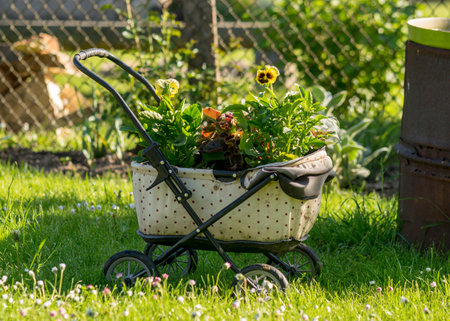Understanding Your Plot: First Impressions and Planning
Stepping onto your very first allotment plot is a bit like unwrapping a present you’ve been waiting ages to open. The soil beneath your boots holds endless possibilities, but before any digging begins, it’s essential to take time for careful observation and planning – this is where your family adventure truly starts.
Assessing the Lay of the Land
Begin by walking slowly around your new patch. Notice how the sunlight falls across different corners during the day – perhaps there’s a sunny spot perfect for tomatoes or a shady nook that might suit leafy greens. Take note of any established trees or stubborn weeds, as they can offer clues about soil health and moisture levels. Bring along your children and ask them what they notice; sometimes, little eyes spot magic we adults miss!
The Feel of the Soil
Scoop up a handful of earth and rub it between your fingers. Is it sandy and gritty, heavy with clay, or somewhere in between? This simple test can help you start thinking about which plants will thrive here and what improvements may be needed. Encourage your little ones to get their hands dirty too – feeling the soil’s texture is all part of connecting with nature.
Dreaming Together
As you walk, chat as a family about what you’d love to grow. Imagine picnics among sunflowers or picking strawberries straight from the plant. This dreaming phase isn’t just fun – it sets the tone for working together on your shared green space. Jot down everyone’s ideas in a notebook dedicated to your allotment journey.
Taking these first gentle steps helps turn an unfamiliar patch of ground into a place full of promise. With thoughtful observation and family imagination, you’re well on your way to preparing healthy, thriving soil for seasons to come.
Gathering Tools and Getting Ready
Before we roll up our sleeves and start turning the earth, it’s time to gather the right tools for our budding allotment adventure. Like a family packing for a day out, preparing your kit together can be the first joyful step. Here’s a gentle guide to what you’ll need, with some handy hints for making this stage fun and meaningful for everyone—especially little helpers!
Essential Tools for Virgin Allotment Plots
| Tool | Purpose | Kid-friendly Role | Eco Tip |
|---|---|---|---|
| Spade | Turning soil, digging beds | Let children choose a small hand trowel or mini spade | Look for second-hand or wooden-handled options from local shops |
| Fork | Breaking up clods, aerating soil | Supervise children as they help break up small patches of earth | Bamboo or recycled steel are more sustainable choices |
| Rake | Smoothing soil, removing stones | Younger ones can use a child-sized rake for light jobs | Borrow from neighbours to reduce waste |
| Watering Can | Keeping soil moist for easier digging | Kiddies love filling and pouring water—make it their job! | Opt for metal cans over plastic; check local car boot sales |
| Gloves | Protecting hands from brambles and nettles | Pint-sized gloves make little ones feel part of the team | Select biodegradable or natural fibre gloves where possible |
| Tarp or Bucket | Catching weeds and debris as you clear the plot | A simple bucket is easy for children to carry around and fill up | Upcycle old containers from home instead of buying new ones |
Sourcing Locally and Sustainably in the UK
Your local garden centre, community tool library, or even friendly neighbours can be wonderful resources. Consider visiting charity shops or swap events—these are treasure troves for affordable, pre-loved gardening kit. Not only does this support sustainability, but it’s also a chance to connect with your community—perhaps pick up a few stories along with your spade!
If you’re shopping new, look out for British-made brands that prioritise eco-friendly materials. Many towns have “Men’s Sheds” groups that repair old tools, making them good-as-new at a fraction of the environmental cost.
Making Preparations Fun for Children
Laying out all the tools and explaining their names and uses turns sorting into a discovery game. Invite your child to help clean any muddy handles or match up pairs of gloves. You might even let them decorate their own hand trowel with stickers or paint—a special touch that encourages pride in shared work.
The process of gathering tools isn’t just practical—it’s a gentle introduction to teamwork, responsibility, and respect for nature’s resources. By choosing local and eco-conscious options together, you plant seeds of stewardship that will blossom alongside your crops.
![]()
3. Clearing the Plot: Making Space for Growth
Before planting dreams into your new allotment, it’s time to give your plot a fresh start by gently clearing away what’s already there. This is a wonderful opportunity for hands-on family teamwork, and an ideal way to introduce children to the importance of caring for both plants and the small creatures that call our soil home.
Practical Steps for Gentle Clearing
Begin by surveying your patch together—notice the wild brambles, stubborn weeds, and perhaps a scattering of old debris left behind by previous tenants or nature herself. Arm yourselves with sturdy gloves, a wheelbarrow, and plenty of enthusiasm! Start at one end, working methodically across the plot. Pull up large weeds by hand or with a garden fork, shaking off excess soil to preserve precious topsoil. For brambles, snip back stems before carefully digging out the roots; this prevents regrowth without disturbing too much earth.
Respecting All Living Things
As you clear, remember: every patch of ground is bustling with life beneath the surface. Encourage children to look closely for wriggling earthworms and scurrying beetles. Use gentle hands to relocate these tiny garden helpers rather than harm them. Avoid using harsh chemicals—nature-friendly gardening means letting beneficial insects stay right where they belong.
Creative Activities for Little Gardeners
Turn clearing into an adventure by challenging children to spot as many different mini-beasts as possible—a simple “worm count” can spark curiosity about soil health. Gather twigs, pinecones, and hollow stems from your clear-up to build a bug hotel together in a quiet corner of the plot. Not only does this provide shelter for helpful insects, but it also teaches respect for all creatures great and small.
By making space thoughtfully and playfully, you lay the groundwork for healthy plants and lifelong learning—nurturing both your allotment and your child’s wonder at the natural world.
4. Nourishing Your Soil: Testing and Improving Fertility
Before you can grow a bumper crop, it’s vital to know what your soil needs—think of it as listening carefully before telling your story. Testing the soil is a fun, hands-on way for families to start this journey together. You don’t need fancy gadgets; just a few basic tools and a sprinkle of curiosity.
Simple Soil Testing Techniques
You can easily check your soil’s texture by rubbing a moist handful between your fingers. Is it gritty like seaside sand, silky like flour, or sticky like dough? Another classic allotment trick is the “jar test”: pop some soil into a clear jar with water, give it a good shake, then let it settle overnight. The layers that form reveal how much sand, silt, or clay you have—perfect for little scientists in the making!
| Test | What You Need | How It Helps |
|---|---|---|
| Texture Test | Your hands, water | Identifies clay, loam or sandy soils |
| pH Test | Soil pH kit (from garden centre) | Tells if soil is acidic, neutral or alkaline |
| Jar Test | Jar, water, soil sample | Shows proportions of sand/silt/clay |
The Magic of British Compost and Manure
If there’s one thing every experienced plot-holder will tell you, it’s this: compost and manure are the heart and soul of an allotment. British compost—whether homemade from kitchen scraps or collected from council green waste bins—brings worms wriggling and plants thriving. Well-rotted horse manure (always ask around at your site!) adds richness and boosts soil structure. Both are simple enough for children to help spread—a real mud pie moment!
Easy Family-Friendly Ways to Boost Soil Health
- Mulch Together: Lay down cardboard and cover with grass clippings or leaves—a treasure hunt for mini-beasts!
- Sow Green Manures: Quick-growing plants like mustard keep soil covered and healthy through winter.
- Add Kitchen Scraps: Banana skins and eggshells from breakfast can be dug straight in by little hands.
Stories from Allotment Neighbours
Maggie next door swears by her grandkids’ help turning compost—they pretend they’re pirates hunting for black gold! Meanwhile, Ahmed on plot 7 showed us his secret: a tea-bag soaked in water makes a gentle feed for young seedlings. These shared tales remind us that nourishing the soil is about more than nutrients—it’s about growing memories together on our British plots.
5. Turning and Preparing the Earth
Rolling up your sleeves to prepare a virgin allotment plot is a rite of passage for every UK gardener. Whether you’re tackling heavy British clay or lighter loam, turning and preparing the earth is more than just a chore—it’s an adventure in patience and teamwork, much like raising children.
Step-by-Step Digging: The Traditional Approach
Begin by marking out manageable sections of your plot. Using a sturdy spade, slice into the soil to a spade’s depth, turning each clod upside down. Remove persistent weeds as you go—bindweed and nettles are stubborn British companions! This method aerates the soil and helps roots penetrate deeply. It’s hard graft, but working side-by-side with family or fellow plotholders can turn it into a bonding activity, with plenty of tea breaks and laughter along the way.
No-Dig Techniques: Gentler on Soil—and Backs!
If digging feels daunting, try the increasingly popular no-dig approach. Lay cardboard over weedy ground, then top it with a thick layer of compost or well-rotted manure. Over time, worms do the work for you, improving structure and fertility without disturbing delicate soil life. No-dig beds are perfect for involving children—let them help spread compost and discover wriggling worms beneath their feet.
Taming the Famous British Clay
Clay soils are common across the UK and can be tricky. To make it workable, dig when it’s moist but not waterlogged; too wet and it clumps, too dry and it’s rock-hard. Incorporate organic matter like leaf mould or garden compost to improve drainage and texture. Children can learn patience here: watching heavy clay transform over time is a lesson in how small efforts add up to big changes.
Growing Together: Lessons Beyond the Soil
Preparing an allotment teaches teamwork—each member brings their own strengths, just as every plant contributes to the plot’s tapestry. Children learn that success doesn’t happen overnight; like seeds sprouting after careful tending, progress in soil preparation comes from persistence and cooperation. As hands get muddy together, families grow stronger roots—both in the garden and in their relationships.
6. Laying Out Beds and Paths
Once your soil is prepped and full of promise, it’s time to design your allotment’s beds and paths. Think of this as laying out a welcoming patchwork quilt—one that invites both big boots and tiny wellies to explore. A sensible layout not only keeps plants happy, but also makes tending and harvesting a pleasure for the whole family.
Traditional British Plots: Order and Ease
Classic British allotments often feature rectangular beds separated by straight, grassy or bark-chip paths. This tried-and-true approach keeps things neat, allows easy wheelbarrow access, and ensures each plot is manageable. Aim for beds no wider than 1.2 metres (about 4 feet) so even little arms can reach the middle without trampling precious seedlings. Paths should be at least 45cm (18 inches) wide—ample for skipping down hand-in-hand or parking a trug of potatoes.
Modern Permaculture Twists
If you’re feeling adventurous, borrow from permaculture’s playful spirit. Try curved beds that mimic nature’s flow or keyhole shapes which maximise growing area while keeping everything within easy reach—perfect for curious children who love to wander. Mulch pathways with wood chips or straw to create soft landings for small falls and muddy knees, while also suppressing weeds.
Safe Spaces for Little Helpers
Consider creating a “children’s corner”—a mini-bed just for young gardeners to dig, plant, and discover worms up close. Keep paths free from trip hazards and avoid sharp-edged materials; log edging or woven willow borders add rustic charm while protecting tender toes.
Tending Together
Whether you opt for straight lines or gentle curves, remember: the best layouts invite participation from all ages. Let children help mark out paths with sticks or string—they’ll take pride in their patch and learn how every footstep matters in a living garden. Soon enough, those little footprints will be guiding you along sun-dappled rows of thriving veg and happy memories.
7. Welcoming Wildlife and Planning for the Seasons
After all your hard work preparing the soil, it’s time to think beyond just planting vegetables—let’s invite nature into our new allotment and map out a year of family adventures. Encouraging biodiversity isn’t just good for your plot, it brings a sense of wonder for children and adults alike. By making space for local wildlife, we help balance pests naturally, pollinate our crops, and foster a thriving mini-ecosystem.
Making Your Allotment Wildlife-Friendly
Start with simple touches: leave a small pile of logs or stones in a quiet corner as a home for hedgehogs and insects. Let one patch of nettles or wildflowers grow untamed to welcome butterflies and bees. A shallow dish of water creates a bird bath, while bug hotels made from old canes or bricks can be a brilliant project for little hands. Avoid using chemical sprays; instead, encourage natural predators like ladybirds and frogs to do their work.
Planning Together for Seasonal Delights
Each season on the allotment brings its own magic. As a family, gather around the kitchen table with seed catalogues and dreams of what you’d love to grow together—crisp spring radishes, summer sunflowers, autumn pumpkins, or winter greens. Mark special dates in your calendar: the first sowing day in March, sunflower measuring contests in July, or apple-picking picnics in September.
Seasonal Activities to Look Forward To
Spring calls for bug hunts and making bird feeders. In summer, try twilight moth spotting or build a mini pond from an old washing-up bowl. Autumn is perfect for leaf collecting and spotting spiders weaving webs among the beans. In winter, leave seed heads standing for birds to snack on and hunt for animal tracks after frosty mornings.
Growing Connections—With Nature and Each Other
An allotment isn’t just about what you harvest—it’s about watching fledglings take their first flight, noticing the first frogspawn appear, or sharing a flask of hot chocolate on chilly days while you plan next year’s adventures. By welcoming wildlife and tuning into the seasons together, your family grows closer—not only to each other but also to the living world that surrounds your plot.


